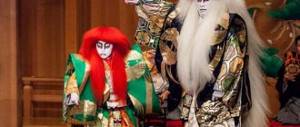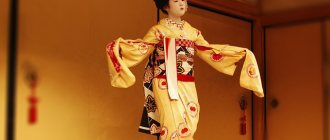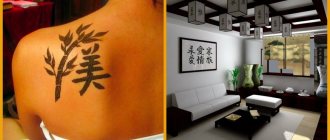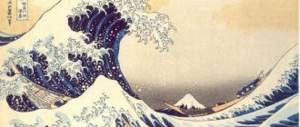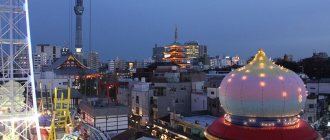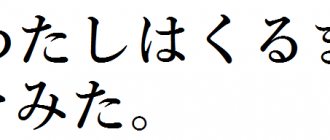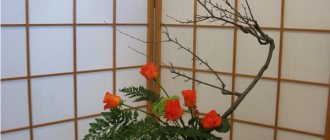Kabuki in the Land of the Rising Sun is considered a complex art form. Kabuki actors prepare very carefully for each performance. Before the performance, the actors apply complex makeup and wear national clothes. Any action in Kabuki is determined by Japanese symbols. There is no room for trifles, there is utmost attention to detail. Colors, hieroglyphs and movements are subject to certain canons.
Kabuki: historical background
Kabuki as a genre originated in the 17th century. The origins of this genre lie in the ritual dances performed by the priestesses of the Izumo Taisha cult. The founder of the genre is Okuni. It was she and other ministers of the religious cult who managed to achieve its wide spread throughout Japan.
On the Kabuki stage in those days, scenes from everyday life were staged, and any roles were entrusted only to actresses. The first cast of the theater was invited to perform in front of the emperor himself. In addition to the main dramatic company, other theatrical associations began to emerge, which helped the genre acquire new subtleties and elements.
Initially, the theatrical performance looked like indecent and mundane performances. Some theater actresses led an indecent lifestyle. In 1629, the Tokugawa shogunate issued a ban that limited women's ability to shine on stage, but Kabuki was so popular that men began to play roles in theatrical productions instead of women.
Everyday scenes, as a theme for theatrical productions, have ceased to be the basis of the repertoire. They were replaced by national dances, dramatic art and sublime stories. During the Meiji period, Kabuki theater declined. Widespread Europeanization led to the fact that the genre was reconstructed according to the European model. Special towers were no longer used in productions. And they began setting up chairs for the public.
In 1928, Kabuki ceased to be the prerogative of Japanese scenes. Adherents of this genre began to travel around the world, showing their performances in the Soviet Union, the USA and many other countries. During World War II, many actors were taken to the front. The bombings destroyed the theater buildings, and those stages that managed to survive became clubs for the military. Many productions were banned. Only a few of them were included in the list, which was allowed to be presented to the general public.
In 1945, the Zenshinza troupe resumed its activities and showed the audience the play Sukeroku. This play was an indispensable attribute of the classical repertoire of any Kabuki theater. Nowadays, the Japanese still value and love this direction. Many actors who perform roles in theatrical productions also play in films and participate in television shows. Women were again given the opportunity to perform roles in plays. In 2005, Kabuki was included in the “third declaration of heritage masterpieces.” Now this genre is officially recognized by UNESCO.
History of Kabuki
If Kabuki itself can be described as a “colorful” genre, the same applies equally to its history. The long process of kabuki evolution began on the banks of a river in Kyoto in 1603. The founder of the genre was Okuni (who was a servant of the Izumo Taisha Shrine). Her ritual dances in a dry riverbed near Kyoto attracted hundreds of spectators. Soon Okuni began to use romantic and social dances in her performances. It didn’t take long before the woman became famous throughout the capital and began performing with the troupe on the stages of Kyoto.
Her dances may have been based on earlier Buddhist temple dances, while the music of the original kabuki was taken from the more ancient Noh theater. However, kabuki, unlike other forms of theater, began to use a new instrument, the three-string shamisen, which soon became very fashionable.
The short dance numbers and skits performed by the Okuni troupe created a sense of eroticism, as the actresses wore exotic costumes that partially imitated the costumes of the Portuguese missionaries. This first variant of kabuki is believed by some to be associated with prostitution. Therefore, it is not at all surprising that it became so popular in the tea theaters of the neighborhoods. After all, with the help of a new popular genre it was possible to provide customers with a new type of entertainment, and at the same time advertise the priestesses of love on stage. Due to the great popularity of "women's kabuki" and the hype that the genre created among male audiences, officials banned onna kabuki in 1629. This led to the creation of another version of the theater - "wakashu kabuki" or "young men's kabuki". Tea brothels began offering the services of young men, which became popular among bisexual women and their special lifestyle called ukioyo, or "fickle world." Guys playing female roles have gained popularity among male audiences. But this didn't last long. In 1652, officials banned this type of kabuki. However, no one forbade adult men from performing on stage, which led to the creation of a new type of theater - “yaro kabuki”, in which all roles, even female ones, were played by adult male actors.
Continuation of traditions
Gradually in the 17th century, kabuki managed to distance itself from prostitution, and the theater began to attract serious playwrights. Talented actors also made significant contributions to the development of kabuki, creating new types of roles such as onnagata - the female role played by a man, wagoto - the role of an elegant man, and later aragoto - the role of a brutal strong man. Each of them inspired playwrights to create new types of drama.
Kabuki has penetrated literally every sphere of life in the country. In the Kyoto and Osaka area, kabuki was inspired by the erotic, hedonistic "volatile world" or ukioyo that flourished in the "red light districts" of large cities. This lifestyle, with its famous prostitutes and star kabuki actors, was often depicted in colorful mosaics of the time.
In the first half of the 18th century, another vibrant style of kabuki emerged in Edo, which was the seat of the military government, and spread quite quickly. It was called aragoto and was heavily influenced by bunraku puppet theater.
Bunraku and kabuki often had the same repertoire, for example, both types of theater used plays by Chikamatsu Monzaemon (1653-1724), as well as many other famous playwrights. The variety of roles and the style of bunraku greatly influenced the acting and facial expressions of kabuki actors.
The end of the 18th century and most of the next century became the golden age of kabuki theater. Several innovative playwrights expanded the theater's repertoire to include the following categories of plays: jidaimono (history plays), sewamono (domestic plays), kaidanmono (ghost plays) similar to Noh dance dramas, and shiranamono (thieves' plays). As time passed, kabuki theaters grew from simple teahouse stages and later wooden structures reminiscent of early Noh theaters, to truly huge theaters that used more complex techniques. There was also a custom of staging kabuki plays that lasted the whole day. They consisted of several parts: the program opened with the piece jidaimono, and ended with the piece sewamono.
By the end of the golden period of kabuki, most of its existing styles, with a corresponding repertoire, had been created. Entire family dynasties of actors emerged who specialized in certain styles and plays. Of all four "classical" forms of Japanese theater, only kabuki managed to maintain its popularity during the Meiji period (1868-1912). But kyogen also became rare, while bunraku traditions were preserved mainly in Osaka. Kabuki managed to adapt the main themes, lyrics and dances from these older styles of theater.
In the 19th century, the center of kabuki became Tokyo (formerly called Edo), where by the end of the century three large kabuki theaters had been created. Unfortunately, all of them were destroyed by fires and explosions, and only one of them (known as "Kabuki-za") was rebuilt in 1952. Currently, the Tokyo National Theater also serves as a stage for kabuki theater. During the Meiji era, when Western forms of entertainment became fashionable, a new, more realistic type of theater was invented - the so-called "shin kabuki" or "new kabuki", which, however, never gained widespread popularity.
From the 20th century until the early 21st century, kabuki was not the most popular form of traditional theater in Japan. But this was also not a stagnant “museum” genre. Gradually he developed. For example, various, often even opposite, trends have now emerged. Several remarkable actors and playwrights made innovative contributions to modernize kabuki in the 20th century.
Actors and their typical roles
In very few forms of theater have actors played one of the most important roles in the creation and development of an entire art form, as happened in kabuki. There are several categories of roles with different sub-categories. Only the most talented actors can be so versatile that they can perform roles of different categories. It is much more common for an actor to specialize in only one of the categories, since the training of a truly great actor can last throughout his entire life. Let's look at the main types of roles in the kabuki theater.
Wagoto is a young city dweller, usually elegant, even feminine. Most often in the play, he is in love with the famous courtesan. He may be a hero, but often his attempts are useless and even comical. Wagoto wear white makeup and costumes based on the urban fashion of the Edo period.
Aragoto (wild warrior style) is a strong, often aggressive male character who can be good or evil. They wear stylized makeup, loose, baggy suits, and often high-top shoes.
Onnagata is a female role played by a man. She can be seen as the embodiment of the stylized caricature acting technique of kabuki. The practice of using male actors in female roles dates back to the early 17th century, when wakashu-kabuki or "young kabuki men" emerged. When women were banned from performing in this genre in 1629, young boys replaced them. When boy actors were banned in 1652, female roles began to be played by adult men. Throughout the history of kabuki, onnagata actors have been especially admired stars and often dictated women's fashion.
Onnagata roles can be divided into numerous sub-categories, each with their own unique characteristics. Keisei is a flamboyant courtesan, akahime is the daughter of a samurai warlord, akuba is an evil woman from sewamono plays, baba is an old woman, musume is the daughter of ordinary farmers or city residents, etc. In addition to the three main role categories described above, wagoto, aragoto and onnagata, each with their own subcategories, there are also several minor role types: katakiyaku - villains, sabakiyaku - positive male characters, jitsugoto - historical figures, sanmaime - comic male characters.
Various types of productions
The themes of kabuki plays have been drawn from many sources. For example, many plays are the same as bunraku puppet theater productions. Thus, many famous plays can be seen in both bunraku and kabuki. Also, two of the main categories were adopted from the bunraku repertoire - jidaomono (historical plays) and sewamono (everyday plays). Jidaimono plays often make reference to the great epics of the feudal period, such as The Tale of the House of Taira and The Tales of Ise Monogatari. Thus, they tell about the distant past. The magnificent style of costumes in jidaimono plays reflects the fashions that were adopted during the early feudal period of the time. At the same time, the acting style was very stylized. At the same time, sewamono plays were much more realistic, and their costumes corresponded to the fashion adopted during the Edo period. The first sewamono play was staged by Chikamatsu Monzaemon around 1703. In parallel with sewamono, a sub-genre emerged, Sonesaki Shinju, which focused on the lives of ordinary people during the Edo period, rather than the mythical heroes of the past. Many of sewamono's plays were therefore based on real events, and dealt with double suicides committed by "amateurs". The Shinju genre became so popular that it was subsequently banned.
The third major category of kabuki were shosagoto plays, which focused primarily on dance rather than plot. In fact, dance is an integral part of most kabuki plays, but in shosagoto it was dancing that was the main content. Most kabuki plays that were adapted from the Noh repertoire during the Meiji era belong to this category. Kabuki can also be classified according to their themes. They often contain the main plots of the older Noh and Kyogen repertoire (such plays are called matsubamemono). Plays in which the concept of vendetta appears in the plot were called sogamono, in which the theme was the suicide of lovers - shinjumono, plays with ghosts were called kaidanmono, and in which it was about famous thieves - they were called shiranamono.
Scenes and props
During the 18th century, the kabuki stage, which was previously a simple wooden platform, evolved into a complex "magic formation" with several types of curtains, elevators, and even a revolving stage.
In terms of its complexity, the kabuki stage can only be compared with the “baroque stage” that was used in Europe around the same time. Both stages were designed for the performance of various dance dramas. Also, all the equipment of these two types of stages was aimed at impressing the audience. However, there are significant differences between the Western European Baroque scene and the Kabuki scene.
The Baroque stage was made according to European court theatrical traditions, so it was greatly influenced by the scientific discoveries of the Renaissance. This resulted in a stage that was quite tall and deep, making it easy to create the illusion of greater distances. The Kabuki theater, which was actually born in the “pleasure districts,” had a very wide stage, the unusual decorations of which were made in the classical Japanese painting style.
The earliest kabuki performances were performed on temporary stages. When this theater first began to gain popularity, its performances were staged on wooden structures similar to those used in Noh theater. By the end of the 17th century, the kabuki stage had acquired one of the modern hallmarks that still remains today - the hanamichi or "flower path" that leads from the back of the hall in the left corner to the stage itself. In kabuki in the 17th and 18th centuries, specific striped “maku” curtains appeared, which also became one of the “features” of kabuki. Similar curtains are now widely used during dance plays.
The complex systems of elevators and hiding places that can be found on any professional kabuki stage today have evolved over centuries. This allowed actors to appear and disappear in the blink of an eye. The full-size rotating stage, which was first used in Europe in 1896, was used in kabuki as early as 1758. Illusions are one of the most important elements in many kabuki plays. One of the most beautiful stage tricks is "riding the skies" (chunori), in which the actor flies over the stage, or even over the auditorium. Some types of modern productions make full use of such stage tricks.
Acting technique
Kabuki acting technique is largely based on imitating the actions and behavior of people during various historical periods of Japan. The lives of courtiers, samurai and even ordinary citizens were limited and dictated by complex rules of behavior, which were all reflected on the kabuki stage. For example, the spoken language and body language of men and women were very different (something that is still partly preserved in Japan). Exaggerated facial expressions became one of the main components of the acting technique (furi) in kabuki. For example, this was reflected in the role-playing of onnagata characters, whose exaggerated tiny steps became a reflection of the idealized concept of femininity of the Edo period.
Strong male characters, on the other hand, represent masculinity, the cult of which was promoted in the world of the samurai. While the onnagata kept their legs tightly together and moved in tiny steps, the energetic Aragoto characters, on the contrary, walked across the stage with a sweeping, confident gait.
Another striking characteristic of kabuki productions is the use of extremely exaggerated facial expressions. This is very different from the impassive "stony faces" of earlier courtly forms of theater such as bugaku and Noh. In contrast to these forms, in the Kyogen farces, which developed directly from folk theater, exaggerated facial expressions formed an important part of the acting technique. All the above-mentioned aspects, various systems of movements and facial expressions represent the art of playful pantomime (furi) in kabuki. It is as important to kabuki performances as the art of dance, which is divided into two categories: archaic techniques (for example, which were borrowed from Noh) and odori, a freer and more rhythmic type of dance.
Every future kabuki actor begins training from early childhood. He should become familiar with the extensive dance repertoire, especially if he intended to specialize in onnagata roles. In most kabuki plays that were taken from the Noh repertoire, dance is the dominant aspect. Since kabuki is a largely hereditary profession, the art is taught within families. A student may take separate lessons in dance and music, but the bulk of the instruction is provided by a master from one of the surviving families who have practiced kabuki for centuries.
Kabuki stage makeup
An actor's makeup depends on the role he plays. When playing a young charmer or a young man, the face is painted white. To reflect a more mature age, brown shades are added to the makeup. If the script requires the actor to look strong and masculine, various stripes are applied to his face. To enhance the emotional coloring of the character, special Kumadori canons are used. Canon colors: blue black and different shades of red. Scarlet signifies courage, honesty, and loyalty, while black symbolizes spirituality and supernatural powers. Blue in this tradition is interpreted as evil and dark otherworldly forces.
Often, in Kabuki, the roles of women are still played by men. And they make up so skillfully that from the stage it is impossible to distinguish such actors from real women. The basis of this makeup is light shades and a large amount of cosmetics on the face.
Theatrical action in Kabuki
The stage used for productions of this genre looks very unusual. Hanamichi is a wooden platform that is used for actors to exit and is also used during some acts. In general, the stage stretches across the entire hall from the left edge. The scenery used in Kabuki theater is called odogu. The productions actively use a platform with steps, all of them are performed in life size.
In large theaters, the stage itself can rotate, and productions also actively include mechanical hatches and rotating walls.
Japanese Kabuki theater. What kind of art is this? Part 1
The East is a delicate matter, don’t forget. That's news to me too. And Kabuki is a thing that needs to be dosed and taken little by little. Spending half an hour in the gym for the first time is already an achievement. Previously, the performance lasted 10-12 hours, now the performance lasts approximately 6 hours. Agree, it is difficult for a European to sit for so long. Besides, even if you know Japanese, it won't help you, the actors speak Old Japanese.
However, they say that is putting it mildly. It will seem to you that they howl like sirens or like witches at a sabbath, because... The main thing in an actor’s speech is not naturalness, but oratory. Thus, the text is pronounced in a manner of mesmerizing melodic recitation, which is a cross between singing and talking. And when the dialogues are accompanied by musical accompaniment, this gives the actors’ movements more rhythmicity, they become similar to the movements of a strange dance.
The actors move around the stage in the poses of a man twisted by arthritis, and these poses require considerable stamina; they make such grimaces that you involuntarily begin to think: did they all eat spoiled food at once before the performance? Kabuki actors have excellent control of their facial muscles and “know how to tell a story with their face.” Sometimes it looks creepy. So, the crazy hero is obliged to bulge his eyes, distort his mouth and then, according to the laws of the genre... Horror.
A special technique of Kabuki actors, "mie", is used at the climax by the actor playing the main role. He suddenly freezes in a picturesque pose, fixes his gaze on one point and squints his eyes. This peculiar manner seeks to emphasize the greatness of special beauty. It’s no wonder that such greatness makes a European want to scratch his head. “Some kind of crazy,” said one of my friends. This, believe me, is a common reaction of an ordinary European to a Kabuki play. But a creative person, an artist, may be intrigued by Kabuki as something amazing and unique. “Oh, Kabuki is so beautiful and amazing,” said my second friend and expressed his feelings by writing a wonderful poem.
The mentality of the East differs from the mentality of European people, but recently their culture has been increasingly in contact with ours. Kabuki is a different ethics and aesthetics, it’s not easy to get used to, but it’s worth trying to understand and “increase your aesthetics.”
So, are they puppet people or living dolls?
At first, 300-400 years ago, Kabuki was a puppet theater. Therefore, when people replaced puppets, actors had to become living puppets. The scene is reminiscent of a puppet theater - bright colors, unnatural movements, absolutely white faces under fluffy wigs, on which scarlet lips stand out as a bright spot. The painted sun seems to shine like a real one, and the waves of emerald fabric shimmer like a real sea. The costumes worn by the actors are made of expensive brocade, and the interior items are real antiques. Here they suffer gracefully and die gracefully.
Imagine: two fighting warriors in tall sandals, with huge fluttering sleeves, and two-meter swords. They have black and red lines on their faces to represent the symbol of war. Their battle is like a dance: some kind of ritual, frivolous movements. In fact, every movement is carefully verified and thought out. In the end, one warrior kills the other. One day, more than 300 years ago, it really happened. The murdered actor fell at the hands of his stage partner, actor Hankuro. Since then, the name Hankuro has been forever erased from the names of theatrical dynasties, and battle swords have been replaced with wooden ones.
The most perfect doll - the main character - with her slow movements, with a high voice - the embodiment of ideal love. She suffers, and they fight and die for her, and at the same time the European viewer tries with all his might to discern the fragile girl in the man made up.
There are dynasties of Kabuki actors that stretch back up to 17 generations. They pass on their invaluable art of being a puppet from generation to generation. Previously, if a girl was born into an actor’s family, it was a sad event, because only a boy could continue the work of his ancestors. The requirements for an actor are very strict. He must undergo thorough training in many types of theatrical art - dance, music. The acting technique in Kabuki theater is not the result of the actors’ achievements, but the accumulated experience passed on from generation to generation.
There is a legend about an actor who was one of the best onnagata (playing a woman) actors. Once upon a time, onnagata was prescribed to wear women's clothing in everyday life. So, having reached the age of 70, the actor retired. But one day he had a desire to go on stage for the last time and perform the girl’s dance. His wife doubted: what did you come up with, you are already too old and they will laugh at you. The husband pretended to be offended and left the house. After some time, a beautiful girl knocked on the door, she politely inquired about the owner of the house and, having learned that he was not there, said that she would come in later. Burning with curiosity and jealousy, the woman began to question her husband as soon as he returned, who was this beautiful stranger who was interested in him? The husband proudly replied: “I was that girl. Are you sure? So that."
The secret of onnagata beauty is that this beauty is created by the art of men observing the behavior and psychology of women.
To be continued…
Tags: men, theater, traditions, art, actors, Japan
Leading theater characters
Kabuki characters can be divided into the following categories:
- "Tatiyaku" is a hero who can be described as a wise, handsome and brave man. He can be a fighter, a sophisticated handsome man, a hero-lover and a consummate warrior;
- "Katakiyaku" is a negative character who is the antagonist of tachiyaku in many plays. Usually, this is an evil and vile deceiver, but this character can also be revealed as a noble man who, because of his noble position, is forced to commit ugly acts;
- “Dokekata” is a comic character who in all plays is designed to make people laugh with his actions;
- "Koyaku" is a character performed by children;
- "Onnagata" is a female character whose role is played by a man. Onnagata can be of any age. Usually, the female image is shown in a long-sleeved kimono. Onnagata can be a noble lady or a beautiful courtesan. Could be a warrior's girlfriend or a merchant's wife.
Kabuki characters are bright and expressive. Each of them has its own distinctive features, strictly regulated by the canons of the genre.
Features of theatrical productions
All Kabuki plays are quite long in time. They can last more than 3 hours, and some productions have to be adapted for foreign audiences, cutting scenes and episodes. Today in the world there are three types of theatrical plays of this genre:
- Jidai-mono. Such plays look like historical productions, telling about the legends of the Sengoku period;
- Seva-mono. They are everyday ideas that are based on stories that arose after the Sengoku period;
- Sesagoto. Dance performances that perfectly reflect all the subtleties of national Japanese dance.
A standard play takes 5 acts. Most productions use Nagauto's lyrical songs as accompaniment.
The uniqueness of Japanese theater lies in its thoughtful symbolism. An incredible combination of musical and dance numbers is combined with dramatic performances by the actors. And complex makeup and technical effects give incredible results. This theater has gone through difficult times, but has retained its originality and popularity. Kabuki is an authentic Japanese art with a long history. Even a viewer inexperienced in theatrical productions notices how the action taking place on stage captivates from the very first minutes.
The Japanese Kabuki theater has a specificity that is not inherent in any other theater in the world. Kabuki is both a genre and a special structure of the theater itself, and strictly regulated actions on stage that make it possible to reflect the diversity of feelings and emotions embedded in the script.
LiveInternetLiveInternet
Sunday, June 19, 2011 12:56 + to Privalov’s
all notes by the author The traditions and history of Japanese theater are rooted in the very distant past. The direct continuity of the tradition can be traced back almost a millennium and a half, to the era when Buddhism penetrated into Japan from the mainland, and with it music and dances from China, India, and Korea. The famous expert on Japanese culture, Academician N. Conrad, suggested that classical Japanese theater also retained elements of ancient drama, which penetrated to the Far East along a long and roundabout route - through the Hellenistic states of Western Asia, India and China. There are many varieties of classical traditional theater in Japan. I'll try to talk a little about some... KABUKI THEATER. At the beginning of the Tokugawa era, the democratic theater of Japan was born, flourished and bore fruit. It was a Kabuki drama. Kabuki, Japan's most famous classical theatrical art form, has a history of approximately 400 years, first as an exercise to develop women's dance technique (Kabuki odori). Ritual dances were often performed to entertain worshipers at the Shinto shrine in Izumo. They are still performed today at Shinto shrines in Nara and other places. Young girls in thin capes over white kimonos and scarlet hakama, with flowing hair and beautifully made-up faces, dance in the temple hall. Among these temple dancers was a girl named Izumo no Okuni, the daughter of a blacksmith. Ancient chronicles say that she was a beauty with hair soft and long, like willow branches, and her appearance resembled a peach flower. “Her dancing style was majestic,” the chronicles noted, “and her sonorous voice amazed everyone who came to see her.” She was also known for her tender heart and was admired by men and women alike. Around the turn of the 17th century, Okuni arrived in Kyoto and began performing some of the ritual dances in the dry riverbed or on the bustling streets of the ancient capital. The first she performed was the “Buddhist Exclamation Dance,” accompanied by Buddhist prayers (the dance was invented by the Buddhist priest Kuya, responding to the tastes of the people, the dance became very popular). Her beauty and wonderful dancing brought her the sympathy of many admirers and the patronage of feudal princes. Yuki Hideyasu, son of Tokugawa Ieyasu and adopted son of Toyotomi Hideyoshi, was captivated by her beauty and performing skills. It is said that he once gave her his precious coral beads, saying that the glass necklace she was wearing was “too cold and did not spark joy.” Beginning as a loose, informal entertainment for the Kyoto crowd, Okuni gradually added romantic and social dances to her repertoire, performed initially to the accompaniment of the flute, old-fashioned finger drums, and other Noh instruments. Over time, she gained popularity throughout the capital, and her appearance on the small open stage attracted numerous spectators who, after a long era of wars, were hungry for aesthetic entertainment. She skillfully combined various traditional dances, folk ballads, poetic improvisations and other elements into one harmonious whole and thus created the Kabuki theater (the word “Kabuki” consists of three Chinese characters, literally meaning “the art of singing and dancing”), in which young people performed dancers. The adoption of shamisen also contributed to the further development of Okuni theater. This instrument owes much of its popularity to Ryutatsu, a composer also known for his beautiful voice. The pantomime arose through the efforts of Nagoya Sanzaburo, who became Okuni's husband. Comic dialogue was added to the new theatrical dance, and Okuni herself soon began to perform male roles. This new type of performance spread throughout different provinces and caused many imitations. In 1603, Kabuki Okuni finally took shape and took the form of a theater. Okuni initially performed with her group in Kyoto, in the Shijogawara and Kojogawara districts, and in 1604 she built her own permanent stage on the grounds of the Kitano Shinto Shrine. However, despite the glory of the new theater, significant social prejudice remained towards the actors and actresses who participated in it. But, despite the decline in the reputation of Kabuki Okuni, the reason for which was the growing immorality and debauchery of some actors and actresses who still occupied the most despised place in the feudal hierarchy, Okuni herself was at one time greeted with extraordinary warmth in the highest spheres, as exemplified by the patronage of Hideyasu and one noble court lady from Kyoto. Monument to Izumo no Okuni in Kyoto In 1607, the Okuni troupe went to Edo, where, just like in Kyoto and Osaka, its performances became fashionable. During performances, the rooms were always crowded, and the popularity of Kabuki was so dizzying that the Edo samurai fell madly in love with the dancers and staged fights in order to win their sympathy. This seemed unnecessary to the authorities, and they decided to ban the troupe’s performances, although the ban was more likely caused by the behavior of the Edo gentlemen than by the activities of Kabuki himself. In the three largest cities - Kyoto, Osaka and Edo - the number of actresses, inspired by Okuni's example, quickly grew, and the Kabuki performances they performed became a favorite entertainment of the general public. But the development of the theater was accompanied by the detrimental influence of actresses on public morality, and the Tokugawa government issued a number of decrees prohibiting the appearance of actresses on stage. In 1608, a decree was issued allowing Kabuki performances only on the outskirts of the city, where its pernicious influence would have a less detrimental effect on society. Several court ladies who had affairs with handsome Kabuki actors were sent into exile. The government often interfered in Kabuki affairs. In 1626, while a group of actresses were performing in the suburbs of Edo, the theater was so crowded that major riots broke out and the performance was ordered to stop. Finally, the government of the third shogun Iemitsu issued a strict decree in 1629 prohibiting any performances involving women. The Onna Kabuki Theater (women's Kabuki theater) was destroyed. Its place was taken by Wakashu Kabuki (men's theater), which arose at the beginning of the 17th century, in which only young men played. However, since theater that only featured boys and young men also began to be considered morally subversive, the government banned it in 1644. After this, a decree was issued ordering the closure of four leading Edo theaters, as well as puppet theaters and other entertainment centers, the reason for which was the scandalous affair of a Kabuki actor and the wife of a major aristocrat. Under pressure from the theater owners, they were reopened the following year, but in 1648 a decree was issued prohibiting aristocrats from visiting theaters, and in 1656, prohibiting actors from giving performances in samurai estates, even if they were specially invited. The Kabuki theater is unique in many respects - amazing makeup, lush clothes, carefully designed stage equipment, an exalted performance style... Kabuki entertainment requires great skill from the actors. Among kabuki actors, there are entire theatrical dynasties that specialize in certain styles of acting. The artistic techniques of Kabuki theater are passed down from father to son, from son to grandson, and so on, so this art largely remains the property of a limited number of acting families. Each family becomes the custodian of certain roles, and these roles, in turn, are passed on from generation to generation. The existence of onnagata - men playing female roles, after the ban on the performance of actresses, became absolutely necessary and has survived to this day. Even in the middle of the 19th century, when many prohibitions were abolished, women for a long time could not achieve the same perfection in performing female roles as onnagata men, who spent many years accumulating experience. Interestingly, onnagata were required to wear women's dress in everyday life, a practice that was abolished during the Meiji Restoration in 1868. There are aragoto ("rough style") and vagoto ("harmonious style"). Standard Kabuki male roles: the handsome lover, the virtuous hero, or the evil samurai; Standard roles for onnagata: noble lady, young girl, evil woman. In modern Japan, the genre of traditional Kabuki theater remains popular and loved by millions of spectators. A distinctive feature of the stage in this theater is the “hanamichi” platform extending into the auditorium, onto which the actors carry out the action of the performance. Being directly among the audience, under the sharp sight of hundreds of eyes, the acting cannot but be distinguished by genuine professionalism and a wealth of facial expressions. Often, a significant part of the theatrical action is transferred to hanamichi, which leads to the complete subordination of the audience to the acting skills, and ultimately contributes to the unity of spectators and actors. Many theaters in Europe took advantage of this Kabuki invention, also beginning to bring theatrical action into the auditorium with the help of special platforms. The rotating stage (mawaributai) is another invention of the Kabuki theater. On small elevations on both sides of the stage, musicians and singers are located in special boxes, who accompany particularly significant episodes of the performances with music, adding to the drama of the moment. The change of props takes place with the scenes open: people in black (kuroko), who are considered invisible, quickly and quietly remove objects from the stage, replacing them with new ones. The ban on women acting in Kabuki has long been lifted, but loyalty to tradition does not allow the centuries-old foundations to be broken, and women’s roles are still brilliantly played by men. In addition, actors in the role of onnagata are so skillful at impersonating women that their performance is one of the main advantages of traditional Japanese Kabuki theater. There is even an opinion that it was the onnagata who preserved the true Japanese ideal of female grace and beauty, and not real modern Japanese women. In the pictures: our contemporary, Kabuki theater actor Tachibana Daigoro. There are several categories of kabuki plays: - Odaimono - historical dramas based on the events of the Heian era. The setting is mainly the palaces of Kyoto, and the characters are the court aristocracy. — Jidaimono are historical dramas based on the events of the Genpei period and subsequent periods until the end of the 16th century. The heroes of these plays are samurai and warriors. — Oiemono – family plays. Social dramas based on events that took place in the families of feudal princes during the Edo era (1603-1876) Sevamono - everyday plays. Dramas based on the lives of ordinary people in the Edo era. Popular kabuki theaters in Japan are Kabukiza in Tokyo, Shin-Kabukiza in Osaka or Minamiza in Kyoto. Kabuki performances last about 5 hours. The central theme is human feelings... Kabuki was and remains a whole world with its own laws, foundations, hierarchy and prejudices, remaining faithful to the unshakable Japanese traditions and without losing touch with modernity.
| Categories: | Interest corner Photography |
Tags:
photo Japan kabuki theater
Cited 5 times Liked by: 3 users
Like share
0
Like
- 3
I liked the post - Quoted
- 1
Saved
- Add to quote book
- 1
Save to links
Liked3
0
